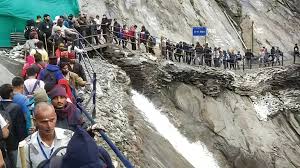Amarnath Yatra resumes after day-long suspension amid heavy rains, landslides

The Amarnath Yatra resumed on July 18, 2025, following a one-day pause caused by intense rain and landslides in Jammu and Kashmir. Thousands of devotees had to wait as officials worked through the night to make the routes safe again. Now, with the weather easing and the paths cleared, pilgrims are once again moving toward the holy shrine.
Swift Response After Weather Disruption
On July 17, the authorities suspended the Yatra due to heavy rainfall and falling rocks along the two main routes — Pahalgam (48 km) and Baltal (14 km). The rain made the steep, narrow trails dangerous, raising fears of accidents and injuries. In response, rescue teams acted quickly. The Indian Army, Border Roads Organisation (BRO), and CRPF joined hands to clear debris and secure the routes.
Thanks to this rapid effort, the Yatra restarted early Friday morning. Over 7,900 pilgrims left the Jammu base camp, heading for the cave shrine in the Himalayas.
Pilgrims March Ahead With Devotion
Despite the rain and disruption, the pilgrims showed unwavering faith. Many stood in queues wearing ponchos, chanting prayers, and expressing gratitude to officials. For them, the journey to the cave is not just physical but deeply spiritual.
Since the Yatra began on July 3, more than 2.5 lakh devotees have already reached the Amarnath cave shrine. This number highlights the significance of the pilgrimage and the deep devotion people feel for Lord Shiva.
Strong Safety Measures in Place
With the monsoon still active, the administration continues to prioritize safety. Pilgrims must register in advance and pass a health check before beginning the trek. The region’s high altitude and unpredictable weather demand physical readiness.
To enhance safety:
- Rescue teams remain stationed along vulnerable spots.
- Medical tents, oxygen booths, and check posts support those who face difficulty.
- Helicopters are on standby for emergencies.
Officials also advise pilgrims to check weather updates and follow instructions from security personnel. Anyone without registration or medical clearance must turn back.
Two Scenic Yet Challenging Routes
Pilgrims can choose between two routes:
- Baltal, which is shorter but steep and physically demanding.
- Pahalgam, which is longer but more gradual and scenic.
On July 18, 5,000 pilgrims used the Pahalgam path, while 2,900 chose Baltal. Helicopter services are also available for those with limited mobility or time.
The Sacred Cave: Heart of the Yatra
The Amarnath cave sits at 3,880 meters above sea level, hidden among snow-covered peaks. Inside, a natural ice lingam forms each year — believed to represent Lord Shiva. According to Hindu mythology, Lord Shiva revealed the secrets of immortality to Goddess Parvati here.
The ice lingam forms naturally and melts depending on weather. Pilgrims consider it a divine sight. Visiting the shrine during Shravan month (July–August) is believed to bring spiritual blessings.
Managing the Yatra: Faith Meets Planning
The annual Yatra is not just a spiritual event. It is also one of India’s most complex logistical operations. The Shri Amarnath Shrine Board (SASB) works with the government to manage crowds, routes, shelters, and safety.
Key management features include:
- Digital registration and health records
- RFID tracking for real-time monitoring
- Public announcements and mobile connectivity
- Sanitation, waste disposal, and food distribution
This year, the administration focused on eco-friendly practices. Single-use plastics are banned. Mobile toilets, dustbins, and awareness campaigns aim to keep the mountains clean.
Unpredictable Weather Still a Concern
While the Yatra resumed, weather remains a challenge. The India Meteorological Department (IMD) warned of more rain in the coming days. Landslides or flash floods remain possible.
Officials may suspend the Yatra again if needed. Pilgrims are urged to follow alerts and avoid unnecessary risks.
Conclusion: Faith, Strength, and Community
The quick resumption of the Amarnath Yatra reflects the strength of both the pilgrims and the administration. When weather halted the journey, teams acted fast. When danger passed, thousands stepped forward with faith.
For many, this journey is more than a visit. It is a test of will, a show of devotion, and a way to connect with the divine. As the Yatra continues until August 9, every step reflects a deeper belief — that no obstacle is too great when faith lights the path.






